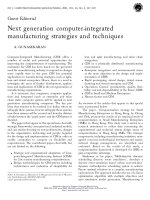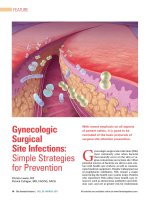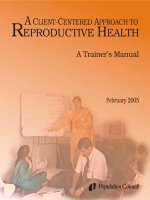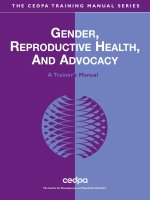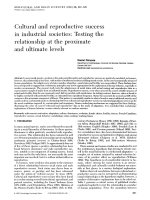Investigating Reproductive Strategies docx
Bạn đang xem bản rút gọn của tài liệu. Xem và tải ngay bản đầy đủ của tài liệu tại đây (4.11 MB, 21 trang )
There are two modes of
reproduction; sexual and
asexual.
There are advantages and
disadvantages to both sexual
and asexual reproduction.
Illustrated information sheets
for 12 organisms.
A reference list for more
information about the
organisms used in this activity.
A list of learning objectives and
key ideas to help you guide
classroom discussion during
the activity.
S
pecial Features
You’ll Find Inside
Class Time:
50 minutes
10 minutes to review activity and make
copies of student pages
Prep Time:
L
ogistics
Time Required
Copies of student pages
None
Materials
Prior Knowledge Needed
Appropriate For:
Students work in pairs to compare five aspects of
an organism that reproduces sexually with one that
reproduces asexually. As a class, students share
their comparisons and generate a list of general
characteristics for each mode of reproduction, and
discuss the advantages and disadvantages of both.
A
bstract
L
earning Objectives
Module
© 2008 University of Utah
This activity was downloaded from: />Print-and-Go™
The Basics and Beyond:
An Introduction to Heredity
Investigating Reproductive Strategies
Primary Intermediate Secondary College
1. Divide students into pairs.
2. Hand each pair:
The » Investigating Reproductive Strategies worksheet (page S-1)
2 organism descriptions - one for an organism that reproduces sexually and one for an organism that »
reproduces either asexually or using both strategies - (see chart below).
3. Instruct each pair to read about their assigned organisms and complete the comparison table on the
Investigating Reproductive Strategies worksheet.
4. When all pairs have completed the comparison table, have them post their tables around the room.
5. Ask students to walk around the room and read the comparison tables with the goal of creating a list
of general characteristics for organisms that reproduce sexually and one for organisms that reproduce
asexually.
6. As a class, compile lists of general characteristics
for organisms that reproduce sexually and
asexually on the board. Learning objectives and
discussion points for each category on the Investigating Reproductive Strategies worksheet are listed on
pages 2-4 to help you guide the discussion.
7. Ask students to discuss the advantages and disadvantages of each mode of reproduction in their pairs.
Have them prepared to support their reasoning.
8. Add advantages and disadvantages to the list of general characteristics for each mode of reproduction.
9. Lead a discussion on the types of situations or conditions in which each mode of reproduction would be
most advantageous or disadvantageous. Do students think one reproductive mode is generally better? Why?
C
lassroom Implementation
Sexual Asexual Both Sexual and Asexual
Blue-headed wrasse Amoeba Brittle star
Duck leech Salmonella Meadow garlic
Grizzly bear Whiptail lizard Spiny water eas
Leafy sea dragon
Red kangaroo
Sand scorpion
Reproductive strategies used by organisms described in this activity:
Tip: You may wish to have students record their
ideas on a sheet of paper while they read the
comparison tables
Investigating Reproductive Strategies
Module
© 2008 University of Utah
This activity was downloaded from: />Print-and-Go™
The Basics and Beyond:
An Introduction to Heredity
1
What are the advantages and disadvantages of sexual and asexual reproduction? Is one “better” than the
other? You are an ecologist who wants to nd out. To answer these questions you decide to compare 5 aspects of organisms that reproduce
sexually with organisms that reproduce asexually. You will begin your study by looking at two different organisms. Once your comparisons have
been made, you will share your information with all of the other ecologists in your class to draw general conclusions about each method of
reproduction.
Fill in the table below with information for each organism you have been assigned.
Sexual Asexual
Relative
complexity
of organism
(including size):
Learning Objectives/Discussion Points:
• Complex organisms tend to reproduce
sexually.
Learning Objectives/Discussion Points:
• Simple organisms tend to reproduce
asexually.
Number of
parents who
contribute genetic
information to the
offspring:
Learning Objectives/Discussion Points:
• Two parents contribute genetic information.
• Offspring have a combination of genetic
information from their parents which makes
them unique from their parents and from
each other.
Learning Objectives/Discussion Points:
• One parent contributes genetic information.
• Offspring are exact genetic copies (clones) of
the parent.
Reproductive
mechanism:
Learning Objectives/Discussion Points:
• Involves the combination of gametes from
two parents.
• With the internal fertilization of eggs by
sperm, the chances of gametes meeting are
increased. Fewer eggs and/or sperm may be
produced by an individual.
• When eggs and sperm are released outside
the body, the gametes may not necessarily
meet. Organisms that reproduce in this way
must produce many gametes.
Learning Objectives/Discussion Points:
• Asexual reproduction does not involve
gametes.
• Reproduction is by splitting in half, or
forming new individuals that are released
from the “parent”.
Investigating Reproductive Strategies
Module
© 2008 University of Utah
This activity was downloaded from: />Print-and-Go™
The Basics and Beyond:
An Introduction to Heredity
2
Learning Objectives
Sexual Asexual
Relative amount
of parental care:
Learning Objectives/Discussion Points:
• Organisms tend to have longer gestation
periods and developing offspring are
protected.
• Organisms tend to care for their young
in some manner, increasing the chances of
survival.
• Organisms that invest time and energy in
caring for their young tend to have fewer
offspring.
• Not all sexually reproducing organisms
gestate or care for their young. These
offspring are vulnerable to predators or the
environment. In these cases, large numbers
of gametes and/or offspring are produced,
presumably to help offset the frequently
high death rate of offspring before they can
reproduce.
Learning Objectives/Discussion Points:
• Organisms tend to have little or no parental
care.
• Organisms that reproduce by forming new
individuals that separate from the parent
provide a form of parental care to offspring
before they are released.
• Organisms that do not care for their young
tend to produce large numbers of offspring.
• Organisms where few offspring survive to
reproduce have large numbers of offspring.
• Organisms that split to produce an “adult”
offspring often can rapidly reproduce again.
Genetic variation
in offspring:
Learning Objectives/Discussion Points:
• Genetic variation only results from sexual
reproduction in which the genetic
information from two parents combines.
• Genetic variation helps a species (as a
whole) survive. In the event of a change in
environment or increased competition for
resources, organisms with slightly different
traits (due to genetic variation) may have a
survival advantage. These differences provide
the variations that natural selection can act
on, resulting in new adaptations.
Learning Objectives/Discussion Points:
• There is no genetic variation in offspring.
Should a change in environment or
competition for resources occur, there is no
variation in traits among offspring that may
provide some with a survival advantage.
• If a parent has traits that are well adapted
to a particular environment, its offspring will
have these same traits, which may provide
them with a survival advantage.
Investigating Reproductive Strategies
Module
© 2008 University of Utah
This activity was downloaded from: />Print-and-Go™
The Basics and Beyond:
An Introduction to Heredity
3
Learning Objectives
Overall Learning Objectives/Discussion Points:
• There are advantages and disadvantages to both sexual and asexual reproduction.
• For an individual it is “best” if the greatest number of its offspring survive to reproduce carrying its genes into
the next generation. Some species produce large numbers of offspring, but only a few of these may survive to
reproduce. Other species produce few offspring, but provide extended parental care to enhance each offspring’s
chance of survival.
• For a species it is “best” if individuals survive and reproduce so that the species does not go extinct. Genetic
variation, which only results from sexual reproduction, may provide individuals with a survival advantage and the
evolutionary potential for adaptations to new and changing environments.
• Organisms that can utilize both sexual and asexual modes of reproduction may be most adaptable to different
conditions.
U.S. National Science Education Standards
Grades 5-8:
Content Standard C: Life Science - Reproduction and Heredity; reproduction is a characteristic of all living •
systems; because no individual organism lives forever, reproduction is essential to the continuation of every
species. Some organisms reproduce asexually. Other organisms reproduce sexually.
Content Standard C: Life Science - Reproduction and Heredity; in many species, including humans, females •
produce eggs and males produce sperm. Plants also reproduce sexually the egg and sperm are produced in
the flowers of flowering plants. An egg and sperm unite to begin development of a new individual. That new
individual receives genetic information from its mother (via the egg) and its father (via the sperm). Sexually
produced offspring never are identical to either of their parents.
B. AAAS Benchmarks for Science Literacy:
Grades 6-8
The Living Environment
Heredity •
In some kinds of organisms, all the genes come from a single parent. »
In organisms that have two sexes, typically half of the genes come from each parent. »
In sexual reproduction, a single specialized cell from a female merges with a specialized cell from a male. »
S
tandards
Investigating Reproductive Strategies
Module
© 2008 University of Utah
This activity was downloaded from: />Print-and-Go™
The Basics and Beyond:
An Introduction to Heredity
4
(All websites accessed May 2008)
Amoeba (Amoeba proteus)
Anderson OR. 1988. Comparative Protozoology: Ecology, Physiology, Life History. Springer-Verlag.
Sleigh M. 1989. Protozoa and other protists. Edward Arnold Publishers.
Tree of Life Web Project: />Rogerson A. 1980. Generation times and reproductive rates of Amoeba proteus as influenced by temperature
and food concentration. Canadian Journal of Zoology 58(4): 543-548.
/> /> />Grizzly Bear (Ursus arctos horribilis)
Defenders of Wildlife, Grizzly Bear Fact Page: />Craighead JJ, Sumner JS and Mitchell JA. 1995. The grizzly bears of Yellowstone: their ecology in the
Yellowstone ecosystem. Island Press.
/> /> />Red Kangaroo (Macropus rufus)
Dawson TJ. 1995. Kangaroos: biology of the largest marsupials. Comstock Publishing.
theBigZoo.com. />Yue M. 2001. “Macropus rufus” (On-line), Animal Diversity Web. />accounts/information/Macropus_rufus.html
Duck Leech (Theromyzon tessulatum)
Sawyer RT. 1986. Leech biology and behaviour. Volume I: anatomy, physiology, and behaviour. Clarendon
Press.
Davies RW. 1991. Annelida: leeches, polychaetes, and acanthobellids. In: [Thorp JH and Covich AP. eds
Ecology and Classification of North American Freshwater Invertebrates. Academic Press, Inc.
Wilkialis J and Davies RW. 1980. The population ecology of the leech (Hirudinoidea: Glossiphoniidae)
Theromyzon tessulatum. Canadian Journal of Zoology 58: 906-911.
Wilkialis J and Davies RW. 1980. The reproductive biology of Theromyzon tessulatum (Glossiphoniidae:
Hirudinoidea), with comments on Theromyzon rude. Journal of Zoology London. 192: 421-429.
Meadow Garlic (Liliaceae: Allium canadense)
Connecticut Botanical Society: />R
eferences
Investigating Reproductive Strategies
Module
© 2008 University of Utah
This activity was downloaded from: />Print-and-Go™
The Basics and Beyond:
An Introduction to Heredity
5
Wildflowers of the Southeastern US: />Prairie Wildflowers of Illinois, by John Hilty: inoiswildflowers.info/prairie/plantx/wild_garlicx.htm
Desert Grassland Whiptail Lizard (Cnemidophorous uniparens)
Crews D. 1987. Courtship in unisexual lizards: A model for brain evolution. Scientific American 255: 116-121.
Blanchard DL. Everything you wanted to know about whiptail lizards (Genus Cnemidophorus) and quite a lot that
you didn’t.
/>Studies.GenderBending.Lizard.Mating-1599792.shtml
Salmonella (Salmonella typhimurium)
Saeed AM. 1999. Salmonella enterica Serovar Enteridis in Humans and Animals. Iowa State University Press.
Bell C and Kyriakides A. 2002. Salmonella: a practical approach to the organism and its control in foods.
Blackwell Science.
Guthrie R. 1992. Salmonella. CRC Press.
Centers for Disease Control, salmanellosis. />gi.html
Sand Scorpion (Paruroctonus mesaensis)
Polis G and Farley R. 1979. Characteristics and environmental determinants of natality, growth and maturity in
a natural population of the desert scorpion, Paruroctonus mesaensis (Scorpionida: Vaejovidae). Journal of
Zoology. London. 187: 517-542.
Farley R. 2001. Structure, reproduction, and development. In: Scorpion Biology and Research. Eds: Brownell P
and Polis G, Oxford University Press.
Polis G and Sissom D. 1990. Life History. In: Biology of Scorpions. Ed. Polis G. Stanford University Press.
How the Sand Scorpion Locates its Prey. http://flux.aps.org/meetings/YR00/MAR00/vpr/layy3-03-04.html
Ivars Peterson’s MathTrek. July 17, 2000. Pinpointing prey. />html
Leafy Sea Dragon (Phycodurus eques)
Groves P. 1998. Leafy sea dragons. Scientific American. 279 (6): 84-89.
Brittle Star (Ophiactis savignyi)
Marine Invertebrates of Bermuda, Little Brittle Star. />MarineInvertebrateZoology/Ophiactissavignyi.html
Smithsonian Tropical Research Institute. />Hendler G, Miller JE, Pawson DL, and Kier PM. 1995. Sea stars, sea urchins, and allies. Smithsonian Institution
Press.
Investigating Reproductive Strategies
Module
© 2008 University of Utah
This activity was downloaded from: />Print-and-Go™
The Basics and Beyond:
An Introduction to Heredity
6
Spiny Water Flea (Bythotrephes longimanus)
Smith DG. 2001. Pennak’s Freshwater Invertebrates of the United States. Wiley & Sons.
Dodson SI and Frey DG. 1991. Cladocera and other Branchiopoda. In: [Thorp JH and Covich AP (eds)] Ecology
and Classification of North American Freshwater Invertebrates. Academic Press, Inc.
Caceres CE and Lehman JT. Life history and effects on the Great Lakes of the spiny tailed Bythotrepes.
University of Minnesota Sea Grant. />Sikes BA. June 2002. Species of the Month: Spiny water flea. Institute for Biological Invasions. http://
invasions.bio.utk.edu/invaders/flea.html
Blue-Headed Wrasse (Thalassoma bifasciatum)
Warner RR. Mating behavior and hermaphrodism in coral reef fishes. American Scientist 72: 128-136.
Warner RR and Hoffman SG. 1980. Population density and the economics of territorialdefense in a coral reef
fish. Ecology 61(4): 772-780.
Louch C. Fish Tales. Port Townsend Marine Science Center. />html
Louisa Stark, Genetic Science Learning Center
Molly Malone, Genetic Science Learning Center
Mel Limson, Genetic Science Learning Center
Sheila Avery, Genetic Science Learning Center
Lee Clippard (Writer)
A Howard Hughes Medical Institute Precollege Science Education Initiative for
Biomedical Research Institutions Award.
C
redits
F
unding
Investigating Reproductive Strategies
Module
© 2008 University of Utah
This activity was downloaded from: />Print-and-Go™
The Basics and Beyond:
An Introduction to Heredity
7
What are the advantages and disadvantages of sexual and asexual reproduction? Is one “better”
than the other? You are an Ecologist who wants to nd out. To answer these questions you decide to compare 5 aspects of organisms
that reproduce sexually with organisms that reproduce asexually. You will begin your study by looking at two different organisms. Once
your comparisons have been made, you will share your information with all of the other ecologists in your class to draw general
conclusions about each method of reproduction.
Fill in the table below with information for each organism you have been assigned.
Sexual Asexual
Relative
complexity
of organism
(including size):
Number of
parents who
contribute genetic
information to the
offspring:
Reproductive
mechanism:
Relative amount
of parental care:
Genetic variation
in offspring:
Investigating Reproductive Strategies
Name
Date
© 2008 University of Utah
S-1
Print-and-Go™
Permission granted for classroom use.
Reproductive Strategies
AMOEBA (Amoeba proteus)
Take one look through a microscope at a drop of healthy
pond water and you’ll nd a ton of one-celled organisms
zooming about. Some of these cells move by uttering tiny
hair-like cilia, while others are propelled by large whip-like
agella. You’ll also come across a lot of blobby cells creeping
about and engulng other cells by extensions of their bodies.
These one-celled critters are known as amoeba, and they move
and feed by extending bulges called pseudopodia (false feet).
When an amoeba moves, it reaches pseudopodia away from
its edges and anchors them at their tips. The rest of the cell’s
insides stream into the pseudopodia until the entire amoeba
has slurped into a new location.
Amoebas are found all over the place, from oceans to soil. They play a very important ecological role by making
meals of the huge number of bacteria, algae, and small protists found on this planet. One common amoeba is the
giant amoeba,
Amoeba proteus
. Giant amoebas reproduce by binary ssion, a fancy word that means splitting in
two. When a giant amoeba begins to divide, it pulls its pseudopodia in to form a kind of ball. After its nucleus
doubles, the amoeba constricts in the middle, as if a belt were being pulled tighter and tighter around the cell.
Finally, the two new cells pinch apart, send out pseudopodia, and slink away from each other. In this way, two
identical “daughter” cells are created from one. When conditions are right, this amoeba can divide every 48 hours.
Animal Prole:
Steve Durr
Amoeba proteus with several green algae trapped
inside food vacuoles.
Name
Date
© 2008 University of Utah
S-2
Print-and-Go™
Permission granted for classroom use.
BLUE-HEADED WRASSE
(Thalassoma bifasciatum)
Many animals are born male or female and stay that way for the rest of their lives.
Not so with the blue-headed wrasse, a tropical sh that darts about amongst the corals and sponges in shallow
Caribbean waters. Females of this sh can completely transform into males when the conditions are right.
Blue-headed wrasses, like many reef sh, are small and brilliantly colored. Most of them - young males and
females - are yellow and sport a greenish-black stripe on their sides. The others - the few, the proud, and the
powerful - are older males with showy blue heads, green bodies, and
thick black and white stripes around their collars.
Big blue-headed males defend territories around the reefs, where
they strut their stuff until the smaller yellow females nd them
attractive. When this happens, the female swims with the male and
spawns (releases her eggs). The male quickly fertilizes them with his
sperm before they oat away into the ocean. Blue-headed males can
mate with as many as 100 females per day!
Of course, these big males can lose their territories because of nasty
little things like death and rivalry. When that happens, the largest
yellow female in the area may morph into a blue-headed male and
begin defending a territory. So, some of the blue-headed males were
born male, while others were born female.
For the females that transform into males, this is a great deal. They
can get a lot of their genes into the next generation by laying eggs
when they are younger, and then fertilizing eggs as males when
they’re older.
Animal Prole:
Adult male Blue-Headed Wrasse
Reproductive Strategies
Adult female or young male Blue-Headed Wrasse
Virginia O. Skinner
Juvenile Blue-Headed Wrasse
Virgina O. Skinner
Name
Date
© 2008 University of Utah
S-3
Print-and-Go™
Permission granted for classroom use.
BRITTLE STAR (Ophiactis savignyi)
Peer into the hole of a sea sponge and you may catch a glimpse
of “the world’s most common brittle star,”
Ophiactis savignyi
. These
brittle stars are tiny - only an inch or two across with arms
stretched. They inhabit virtually all of the world’s tropical and
sub-tropical ocean habitats.
Brittle stars are related to sea stars, or starsh, and have a simi-
lar body structure. They’ve got a central disk, which holds all the
important stuff like the mouth, stomach and reproductive organs.
Then there are the arms - long, slender, wavy and edged with
short spines. These arms are what give brittle stars their name.
They can break off voluntarily and regenerate.
O. savignyi
takes the ability to regenerate one step further and
actually splits in half in order to reproduce. When ssion happens,
the brittle star fractures down the middle of its disk, creating two
identical 3-armed brittle stars. These stars then grow new arms
from their empty arm-spaces. But this isn’t the only way
O. savi-
gnyi
reproduces. Like all brittle stars, they also reproduce sexually.
At certain times of the year, large females and males raise their
disks off the surface, balance on their legs, and release sperm and
eggs into the ocean. When the sperm and eggs meet they produce
larvae that oat away to new habitats.
Fission is the main way that
Ophiocomella
reproduces, but since
they don’t move far or fast, this results in large groups of brittle
star clones in one area. Scientists believe that sexual reproduction
might be a good way for the brittle star to populate new areas
far away from their clone-lled sponge homes.
Animal Prole:
Ellen Muller - www.pbase.com/imagine
Brittle star spawning.
Michael Roy
Ophiactis savignyi
Reproductive Strategies
Tamara McGovern
A recently divided Ophiactis savignyi. Three tiny arms
are beginning to regenerate.
Name
Date
© 2008 University of Utah
S-4
Print-and-Go™
Permission granted for classroom use.
DUCK LEECH (Theromyzon tessulatum)
Leeches are the stuff of horror movies and doomed journeys
into infested waters, and this leech is no exception to the rule.
It has the disgusting habit of attaching itself to nostrils, eyes,
throats and even brains. Thankfully for humans, it only does
this in ducks and other waterfowl, earning it the common
name “duck leech.”
The duck leech does a fair job getting around and probably gets spread as ducks move from pond to pond. This
leech, like all leeches, is a hermaphrodite, meaning that a leech has both male and female reproductive parts. But
that doesn’t mean it can move into a pond all alone, reproduce with itself, and start a new leech population. It
still takes two to tango, as they say, and a leech requires sperm from another leech to fertilize its eggs.
When the duck leech reproduces, two leeches rub together
and give each other their sperm. Each leech will use the
other’s sperm to fertilize its eggs before placing them in gooey
cocoons for protection. The leech attaches the cocoons, which
hold as many as 400 eggs, to a rock or other sheltered place.
The parent then waves its body over the eggs, passing fresh
oxygen-rich air over them with the movement of its body. After
21 days, all 400 of the developing young leeches attach to
their parent’s belly. They remain attached there until the parent
nds a suitable bird for a meal. When that happens, the young
bloodsuckers leave their parent behind and attach to the host for their rst blood meal. The parent dies shortly
thereafter, but not before giving hundreds of new eyeball-suckers a shot at the game of life.
Animal Prole:
Young attached to the underside of a parent leech.
Reproductive Strategies
Biopix.dk Biopix.dk
Name
Date
© 2008 University of Utah
S-5
Print-and-Go™
Permission granted for classroom use.
GRIZZLY BEAR (Ursus arctos horribilis)
Grizzly bears used to roam throughout the Great Plains of
North America, hunting elk and moose and nibbling on
berries and grasses. Grizzly bears still do these things, of course,
but habitat loss and hunting have conned the bears to rough,
mountainous areas. In the lower 48 states, they’re only found in
Montana, Idaho, Wyoming and Washington.
Grizzly bears are enormous animals that require large territories, especially when food becomes hard to nd.
Males can weigh as much as 453.6 kg (1000 pounds), females can clock-in around 317.5 kg (700 pounds), and
their territories can be as large as 906.5 square kilometers (350 square miles). Though grizzlies spend most of
their days wandering around alone, they come together to mate during early summer. During mating, the male
deposits his sperm into the female, where her eggs are fertilized. Females delay implantation of the fertilized eggs,
so the embryos don’t begin developing until the females are nestled into their warm dens in November. Mothers
give birth 8 weeks later to between 1 and 4 cubs. Until they leave the den in late spring, the cubs live off their
mom’s milk, which means mom has to eat enough in the sum-
mer and fall to survive hibernation and to feed her cubs, too!
Cubs stay with their mother for 3 years or so. She won’t repro-
duce again until they leave her side. Because reproduction and
growth are slow and the bears need large territories with a lot
of food to survive, grizzlies are sensitive to over-hunting and
habitat loss. Thankfully, they’re protected by the Endangered
Species Act, and many conservation and wildlife biologists are
working to keep the grizzlies a part of our natural world.
Animal Prole:
US Fish and Wildlife Service/Larry Aumiller US Fish and Wildlife Service/ Terry Tollefsbol
Reproductive Strategies
Name
Date
© 2008 University of Utah
S-6
Print-and-Go™
Permission granted for classroom use.
LEAFY SEA DRAGON (Phycodurus eques)
Dragons lurk in the cool waters off the southwestern
Australian coast, but they aren’t the mythical beasts that
devour huge ships before slipping away into the deep.
Instead, these dragons are calm, gorgeous sh known as
leafy sea dragons (
Phycodurus eques
). Though not as large
as mythical dragons, leafy sea dragons can be pretty big.
They grow up to 51 cm (1.7 feet) in length and have
long leaf-like
appendages sprouting from their bodies. This leaness
helps them blend in with their seaweed habitat,
protecting them from predators and giving them an advantage while hunting for food. Like their cousins the
seahorses, leafy sea dragons have long tubular snouts they use to suck up tiny shrimp. To hunt, they drift around
camouaged as a piece of seaweed and ambush their small crunchy prey.
Leafy sea dragons and their relatives reproduce in a way
that’s rare in the sh world: the males carry and hatch
the young instead of the females. When sea dragons
mate, the female nds a potential dad and deposits her
eggs underneath his tail where his sperm fertilize them.
Pregnant dads can have as many as 200 incubating eggs
tucked tightly beneath their tails. It pays to have a dad
that looks like seaweed, because the eggs are protected
from predators there. The eggs cling for 4-5 weeks before
they hatch. The young are less than 2.5 cm (1 inch) long
when they nally hatch. Many of them, sadly, will become
little shy snacks for larger sh, but the lucky ones who survive will grow up to be beautiful adults. Getting
protection from dad when they were developing likely gave them one n up in the vast ocean world.
Jeff Jeffords - divegallery.com
www.stuarthutchison.com.au
Eggs attached under a male sea dragon’s tail.
Reproductive Strategies
Animal Prole:
Name
Date
© 2008 University of Utah
S-7
Print-and-Go™
Permission granted for classroom use.
MEADOW GARLIC
(Liliaceae: Allium canadense)
Long before settlers ventured into North America with their
European garlic and onions, Native Americans were likely
spicing-up their cooking with a native garlic known as meadow
garlic. This garlic, called
Allium canadense
by botanists, grows
wild from Florida to Canada. Surprisingly, it belongs to the
same family as garden-variety lilies - those big colorful owers that perch in ower vases and add splashes of
color to many gardens around the world. Even though it’s called meadow garlic, it really smells and tastes more
like an onion. Rubbing the leaves and stems emits a denite bad breath, onion smell.
Meadow garlic, also known as wild garlic, grows from bulbs like other lilies in its family. The bulbs lie dormant
underground over winter, storing energy for the burst of growth and reproduction that comes in spring and early
summer. Bees aren’t turned off by the onion smell, and they buzz around pollinating the small, pink or white
owers. Although each ower has both male and female reproductive parts, it can’t mate with itself. The bees are
needed to move pollen from one plant to another. This produces fertile seeds that eventually disperse and grow
into new plants that have a mix of genes from the two parent plants.
But meadow garlic doesn’t only depend on bees or other pollinators to spread itself around. Perched underneath
the owers are clusters of little, nubby growths called bulblets. The bulblets are outgrowths of the plant, and when
dropped, sprout into new plants identical to their parent. The bublets provide enough start-up energy for the new
plants to grow and eventually produce owers and bulblets of their own. The ability of plants in the lily family to
reproduce both with and without fertilization means they can spread easily. Some lilies have
actually become pests by taking over pastures, gardens, and roadsides across the country.
Plant Prole:
Larry Allain @ USGS National Wetlands Research Center
Reproductive Strategies
Name
Date
© 2008 University of Utah
S-8
Print-and-Go™
Permission granted for classroom use.
RED KANGAROO (Macropus rufus)
In the desolate, dry plains of central Australia, mobs roam
around the countryside. But these aren’t mobs of people. Mobs
are actually the ofcial name for groups of red kangaroos,
Macropus rufus
. And unlike angry mobs of people, mobs of red
kangaroos aren’t usually to be feared. They are skittish and
will scatter when frightened. When they’re really moving, red
kangaroos can leap as far as 3.7 meters (12 feet) in one jump
and reach speeds of 56 kph (34.8 mph)!
Red kangaroos are one of the largest marsupials, and herbivorous mobs of them bounce about eating grasses and
other vegetation. They’re usually headed by the most mature female and include lots of other females and young
kangaroos, called joeys. When it’s mating time, males will sometimes box each other for females with their power-
ful jumping legs. The winning male deposits his sperm in the female, where an egg is fertilized.
After mating, females give birth to one baby kangaroo, which
has only gestated for about 33 days. The young are very unde-
veloped after such a short time. Like most marsupials, baby red
kangaroos spend a lot of time growing in their mom’s pouches.
When it’s born, a young kangaroo is tiny, pink, hairless, and
blind, but it knows to head straight for the pouch. It swims
through mom’s fur to get there, where it attaches to a nipple
and nishes developing. After about 7 months, a joey gets too
big for mom’s pouch and will leave to bounce around next to
her. Once this happens, the mom gives birth to another tiny
pink baby. Females can continuously give birth and usually
have about 3 joeys every two years.
Animal Prole:
Geoff Shaw -
A newborn kangaroo in its mother’s pouch.
Chris Willis
A mother red kangaroo with a joey in her pouch.
Reproductive Strategies
Name
Date
© 2008 University of Utah
S-9
Print-and-Go™
Permission granted for classroom use.
SALMONELLA (Salmonella typhimurium)
There are times when we eat something and our stomachs hurt
badly, and then there are times when they hurt REALLY badly.
When it hurts dreadfully bad, it could be from food poisoning,
which leads to fever, nausea and diarrhea. Yick. And that’s a
mild case of food poisoning! Some of the more life-threatening
cases can send a person to the hospital.
The interesting thing is, it’s not poisoning at all, but the result of a sinister bacteria known as
Salmonella
. This
one-celled, rod-shaped bacteria is fairly common, and can be found naturally in raw eggs, raw meats, on the
bodies of some reptiles, and in animal feces. It’s when
Salmonella
nds itself in the warm growth chambers of our
bodies that it hits pay dirt.
When
Salmonella
from infected food reaches our small intestine, it divides rapidly, producing copies of itself
through simple division. These bacteria continue to rapidly divide, increasing in number and infecting other cells.
This causes our immune system to respond, but
Salmonella
does a good job of fending it off. It takes about
12-72 hours to feel the effects of a
Salmonella
invasion. Our bodies can ght off some
Salmonella
infections, but
we generally need the help of antibiotics to overcome them.
Thankfully,
Salmonella
is not one of those extreme bacteria that can survive the freezing temperatures of the
Arctic or the boiling heat of volcanic thermal vents. Humans have adapted to
Salmonella’s
existence by cooking,
pasteurizing, and freezing our foods and drinks, which does a good job of killing the bacteria. Still,
Salmonella
infection is common enough and turns up where people aren’t washing their hands or cooking meat thoroughly.
Animal Prole:
Salmonella (rod-shaped) invading human cells.
Rocky Mountain Laboratories, NIAID, NIH
Reproductive Strategies
Name
Date
© 2008 University of Utah
S-10
Print-and-Go™
Permission granted for classroom use.
SAND SCORPION (Paruroctonus mesaensis)
Sinister beasts are underfoot when the sun goes down in the
dunes of the Mojave Desert. The sand scorpion, which spends its
days in a burrow underground, emerges to sting, kill and munch
its prey. Shine an ultraviolet light into the night, and the ground
will come alive with yellow-green glowing scorpions, out devouring
beetles, crickets, other scorpions, and even cannibalizing their own
kind. If it’s the right time of year, glowing scorpions might also be
dancing the night away.
Yep, that’s right, sand scorpions dance during courtship. Males
grasp the females by their pinchers, or pedipalps, and move them
around in circles. After dancing for a while, the male deposits a
packet of sperm on a stick or other surface. Then, he moves the
female until she is on top of the sperm. She takes in the sperm
and fertilizes her eggs internally. The dance ends here, and the
male usually skitters off to nd more mates. But every now and
then, the female rears back, stings the male, and eats him for her
next meal!
Young sand scorpions spend about 12 months developing inside
their mother before they are born live. After they’re born, they
quickly crawl onto their mom’s back where they stay until they’re
big enough to leave the burrow. On average, a sand
scorpion mom has about 33 newborns hitching rides
on her back. But things aren’t always easy there either,
and sometimes the young eat each other or the mom
eats the young. Clearly, stingers don’t make life trouble-
free for the sand scorpion, but they’re still able to be a
very successful organism in their dry, sandy habitats.
Animal Prole:
Mother scorpion (syntropis)
carrying babies on her back.
Spermatophor from a male
scorpion.
Scorpions (Tityus trinitatis) engaged in courtship dance.
© T.C. van der Ende - scorpiology.com
Sand scorpion (Paruroctonus mesaensis) capturing a bur-
rowing cockroadh. Photo taken under UV illumination
Philip H. Brownell, Ph.D.
Reproductive Strategies
Name
Date
© 2008 University of Utah
S-11
Print-and-Go™
Permission granted for classroom use.
SPINY WATER FLEA (Bythotrephes longimanus)
There’s a tiny, transparent crustacean that swims jerkily around
in the Great Lakes. It spikes sh in their mouths with its long
tail and gobbles up other microscopic aquatic animals (zoo-
plankton). It’s called the spiny water ea, but it’s more related
to crabs and lobsters than to any insects. Though many
different kinds of water eas are common in ponds and
streams, the spiny water ea is not a welcome visitor. It’s an
invader from European waters and it competes with local sh
and water eas for food. It’s protected from predators by its
nasty barbed tail, which makes up 70% of its 2 cm long body.
Spiny water eas are a threat to ecosystems because of their
power to rapidly reproduce. Like all water eas, this one
alternates between asexual and sexual phases. Most of the time,
a female produces eggs without fertilization. She releases about
10 eggs into the brood chamber on her back, where they
develop into young clones within several days. During summer,
females can produce clones of themselves every 2 weeks.
When food becomes scarce or temperatures change, some
females produce spiny little males. These males mate with other
females that have produced special eggs used for fertilization,
called “resting eggs.” They’re called this because after these eggs
are fertilized, they leave the mom and remain dormant before
hatching. Many water ea resting eggs can survive drying or being eaten by sh.
Spiny water eas seem to have a lot on their side, and they’re in the Great Lakes to stay. Still, biologists are
working hard to keep them from spreading into too many more lakes in the future.
Animal Prole:
Pieter Johnson, University of Colorado at BoulderPieter Johnson, University of Colorado at Boulder
Different reproductive forms of spiny water eas.
Male (left), female with asexual eggs (center), and
female with sexual eggs (right).
Reproductive Strategies
Name
Date
© 2008 University of Utah
S-12
Print-and-Go™
Permission granted for classroom use.
DESERT GRASSLANDS WHIPTAIL
LIZARD (Aspidoscelis uniparens)
Nothing is ever what it seems in the world of reproduction.
Take the example of the desert grassland whiptail, a species of
lizard that lives in the southwestern United States. These lizards
have long sleek bodies with lines that go from nose to tail.
They race around in the dry leaves and branches eating ter-
mites, grasshoppers, beetles and many other insects. Like normal
lizards, the whiptails perform courtship, mate and lay their eggs.
Sounds pretty ordinary, right? But if we took a closer look, we’d nd that not a single one of these lizards is a
male! This all-female whiptail species is able to reproduce without fertilization, a process that is called
parthenogenesis.
In this species, females take turns playing male during court-
ship and mating. If the “female” is interested, the “male” will
wrap around her and grip “his” jaws around her body. The
couple will stay like this for 5 to 10 minutes. This is called
pseudocopulation or false mating, because no males or sperm
are involved.
The “female” from this mating pair will eventually lay her eggs,
which all hatch into copies of their mom. Females will “mate”
and lay 2 to 3 eggs about 3 times over the breeding season.
It turns out that females who lay eggs after “mating” with
another female lay more eggs than females who don’t mate. Laying a few more eggs is denitely an advantage in
the harsh desert where survival of the young is difcult.
Animal Prole:
NPS - Sally King
Reproductive Strategies
© David Crews, Ph.D., University of Texas at Austin
Two female desert grasslands whiptail lizards en-
gaged in pseudocopulation.
Name
Date
© 2008 University of Utah
S-13
Print-and-Go™
Permission granted for classroom use.

